
Centre of Jaina Studies Newsletter: SOAS - University of London
The generic title Saṃgrahaṇī-sūtras, essentially meaning 'compilation' or 'compendium', is used for a wide variety of texts that describe details of the Jaina universe. The most comprehensive study of these works is Collette Caillat and Ravi Kumar's The Jain Cosmology.[1] The manuscripts of these texts often include many illustrations and cosmic diagrams. The most commonly illustrated Saṃgrahaṇī-sūtra is a cosmological text composed in 1136 by the Śvetāmbara monk Śrīcandrasūri. His Prakrit Saṃghayaṇarayaṇa is also known by its Sanskrit title Saṃgrahaṇīratna, 'Jewel of the Compilation' and titled Trailokyadīpikā, 'Illumination of the Triple World'. The text is a summary of a sixth century work the Bṛhatsaṃgrahaṇī, or 'Large Compilation' by the monk Jinabhadragaṇi. The later work by Śrīcandrasūri is called the Laghusaṃgrahaṇī, or 'Short Compilation'. Many illustrations that are scattered in collections, both public and private, have not been fully studied, but the few complete or near complete manuscripts that I have seen appear to be from the Śrīcandrasuri version. The brightly coloured illustrations in this note (Figs. 1, 3-5, and 7) illustrate this version and are particularly interesting because of the date of their production, VS 1962 or 1905 CE. One often gets the impression that Jaina paintings are all very old, but these represent a living tradition. It is rare, but not uncommon, to find new illustrated manuscripts after editions of these texts had already appeared in print. It is actually rather gratifying to have a late version to consider, even with its rather naive style and use of what appear to be synthetic colours. It underscores the way these texts were and are relevant to the education of the Jaina community
These texts describe in the smallest detail the three worlds: that of man, the heavens above, and the hells below. They also include much that is common to other Indian traditions. A lot of this material is cosmological, but it also includes more mundane items like the rivers and mountains of the islands that make up the level in which humans live. Figure 1 depicts a diagram of the full universe in the shape of a human. The universe is often depicted in the shape of a person with its arms akimbo, logically suggested by shape of the universe as described in Jaina texts, the lokākāśa. Often the anthropomorphic version of the diagram is called lokapuruṣa, but the term is a bit misleading, since this title could imply that the universe is some sort of cosmic man, rather than merely in the shape of a person. A number of these diagrams represent the universe as female as well. Here the analogy with a standing human is graphically portrayed. Divided into three, the universe consists of the ūrdhvaloka or celestial world above the waist; the madhyaloka or middle world, the plain rectangle at the waist; and the adholoka or lower world below the waist. Using this diagram as a guide we can place the various other illustrations in their proper layers in this scheme.
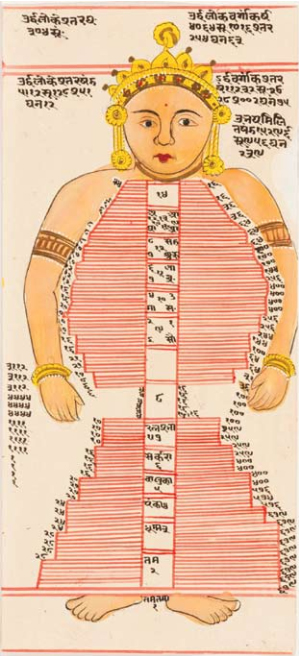
Figure 1
The texts describe the three worlds of the human diagram in great detail and much is made of the quality of ever finer and finer descriptions of the smallest of intricate calculations. Many of the illustrations depict maps and diagrams of the various components of the Jaina universe. Among the subjects frequently illustrated are the different types of gods and their pleasures, the heavenly and hellish regions and their mansions, and the tortures that befall sinners in the different Jaina hells. On the human plane there is a description of many natural features and classes of humans.
The middle world is often depicted by a diagram known as the Aḍhāīdvīpa, the two-and-a-half islands. Its centre island, the Jambūdvīpa, is seen in Figure 2, an illustration from a manuscript executed in VS 1648 or 1591 CE. It depicts the island at the very center of the Aḍhāīdvīpa and it consists of seven continents or varśas. Two-and-a-half of them are truly important to us. These are the karmabhūmi, the worlds of action, where Jinas are born and men can attain enlightenment and mokṣa liberation or release from reincarnation. The other continents are bhogabhūmi, the world of bliss, where humans cannot attain mokṣa. On two of the continents of the karmabhūmi, Bharata at the very bottom and Airāvata at the top, Jinas are born only in the third and fourth kālas or segments of the half-cycles. We are currently living in the beginning of the fifth stage, so Jinas cannot be born in this degenerate time. But in half of the horizontal middle sections, called 'Mahāvideha', Jinas are always living so living Jinas can and do exist there, while not living in our world.
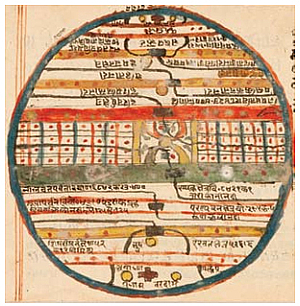
figure 2
Divided into seven layers, the hells that form the lower half of the central figure get larger as one gets deeper the lower the hell the worse the suffering. Scenes of the tortures are often depicted and a detail of the left half of a folio showing some of the torments is seen in Figure 3. These tortures vary depending on the sins committed by each soul. Many folios for the hells include scenes of torture, but others depict the various mansions on those levels, the demi-gods living below the madhyaloka, such as the asurakumāras and vyantara-devas, as well as charts of measurements.
On the heavenly plane we find descriptions of various types of beings, often depicted by their attributes, primarily groups of gods known as the vaimānikas. We also find descriptions and classifications for the heavens, including natural features like trees and mountains. Figure 4 depicts six of the twelve symbols associated with the lower heavens. Heavenly bodies also are illustrated and many folios have to do with aspects of the sun and moon and the nine planets, navagraha. Figure 5 shows the sun surrounded with figures of the directional animals that affect the movement of the planets. Where one would expect a correlation with Hindu cosmology, the animals reflect an entirely different system. In the Hindu construct the elephant for Indra would be in the east and the makara (a composite lion and crocodile) for Varuṇa in the west, the other two directions would be a buffalo for Yama in the south and a human for Kubera in the north. Here we see makara in the east, elephants in the south, bulls to the west and horses to the north.
Among the most esoteric of common diagrams are depictions of the eight black fields, the kṛṣṇarājīs (Figure 6). These exist at the third level of the fifth heaven. The particles of vegetative matter that fill these fields flow up from the madhyaloka right up into the heavens. Importantly, it also includes small yellow circles representing the lokāntika gods that live in that region between the heavens and madhyaloka.
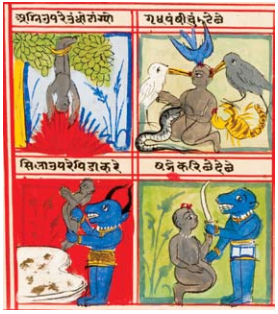
Figure 3
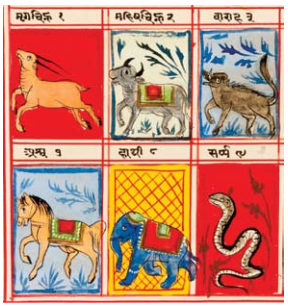
Figure 4
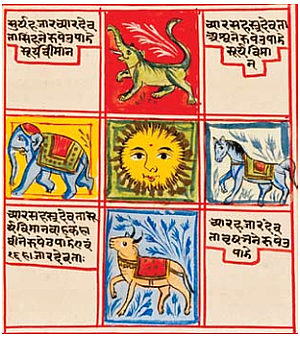
Figure 5
On the human level a telling illustration is that of manuṣya-gati, Human Destiny represented by the leśyās, The Six Taints (Figure 7). In a way they act as a link between the three worlds. For Jainas karma is a physical substance. Activity produces karmic matter that attaches to the soul (jīva). This darkens the soul and dulls its purity. Leśyās reflect the past deeds of an individual and are an indicator of their current moral state. For the Śvetāmbaras, the Uttarādhyayana-sūtra describes these in detail. Each has a distinctive colour from black to white: the black reflecting the greatest sin amongst the soul's past deeds. The common illustration seen here relates a story about a group of starving men who come upon a tree laden with fruit. The worst of the group, the black figure, wants to cut the tree down from its roots. The next slightly lighter colour says just the trunk, and in turn one wants to cut the branches, another only the ones bearing fruit, the next in turn only those with ripe fruit. The white leśyā, the purest soul that has followed the Jaina path only takes the fruit that has already fallen from the tree. This story of the leśyās underscores the importance Jainism places on ahiṃsā toward all living beings, including plants and animals. Each of these souls will end up in various levels of the cosmos depicted by the universe seen in Figure 1, as gods or demi-gods, humans, animals, and plants or in the case of the black figure in one of the hells.
The illustrations found in Saṃgrahaṇī Sūtras allow Jains to visualize the elements of the Triple Worlds in a graphic manner. Depending on one's actions as the soul migrates from one life to another, over the course of countless number of lives, one can be born in any of these worlds. The illustration of the six leśyās in particular makes clear the choices that the soul can make leading to births in a great variety of locations throughout the universe, the lokākāśa.
All of the illustrations here are from The Michael Abbott Collection of Jaina Manuscripts. All are from Saṃgrahaṇī-sūtra loose-leaf manuscripts
References for the leśyās:
Uttarādhyayana-sūtra in Hermann Jacobi, trans. Jaina Sūtras, Vol. 2, (Originally published in Sacred Books of the East XLV 1895, reissued Dover Paperbacks, 1968), pp. 196203.
Norman Brown, Manuscript Illustrations of the Uttarādhyāyana Sūtra, New Haven: American Oriental Society, 1941, chapter 34, p. 48.
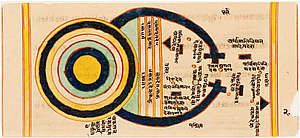
Figure 6
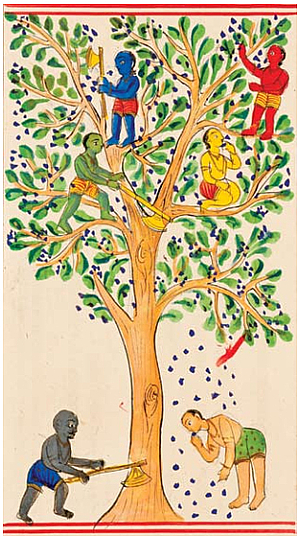
Figure 7
 W. Norman Brown
W. Norman Brown